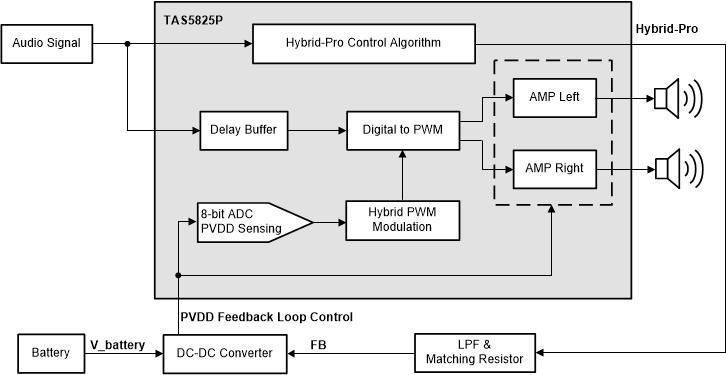JAJSI51A May 2019 – January 2023 TAS5825P
PRODUCTION DATA
- 1 特長
- 2 アプリケーション
- 3 概要
- 4 Revision History
- 5 Device Comparison Table
- 6 Pin Configuration and Functions
- 7 Specifications
- 8 Parameter Measurement Information
-
9 Detailed Description
- 9.1 Overview
- 9.2 Functional Block Diagram
- 9.3 Feature Description
- 9.4 Device Functional Modes
- 9.5 Programming and Control
- 9.6 Register Maps
-
10Application and Implementation
- 10.1 Application Information
- 10.2 Typical Applications
- 10.3 Power Supply Recommendations
- 10.4 Layout
- 11Device and Documentation Support
- 12Mechanical, Packaging, and Orderable Information
パッケージ・オプション
メカニカル・データ(パッケージ|ピン)
- RHB|32
サーマルパッド・メカニカル・データ
- RHB|32
発注情報
3 概要
TAS5825P は、先進の Hybrid-Pro アルゴリズムを備えたステレオ、高効率、閉ループ Class-D オーディオ・アンプであり、クリッピング歪みを発生させずにシステム効率を高めることができます。
通常、オーディオ・アンプの電源電圧 (PVDD) は DC-DC コンバータで供給されます。固定 PVDD に比べて、オーディオ信号に基づいて変化する可変 PVDD は、大幅に効率を向上させ、アイドル電流を低減し、発熱を低減します。
TAS5825P の強力なオーディオ DSP コアは、Hybrid-Pro と呼ぶ独自のアルゴリズムを実装しています。Hybrid-Pro アルゴリズムは、予測されるオーディオ電力の需要を検出し、Hybrid-Pro フィードバック・ピン (HPFB) により、前段の DC-DC コンバータに PWM 制御信号を出力します。TAS5825P は、オーディオ信号を先読みしてオーディオ・クリッピング歪みを防止するために最大 4ms の遅延バッファをサポートしています。各種の実験において TAS5825P は、連続的に音楽を再生しながら、1S および 2S バッテリの動作時間を 50% 以上延長しました。
製品情報(1)
| 部品番号 | パッケージ | 本体サイズ (公称) |
|---|---|---|
| TAS5825P | VQFN (32) RHB | 5.00mm × 5.00mm |
(1) 利用可能なパッケージについては、このデータシートの末尾にある注文情報を参照してください。
